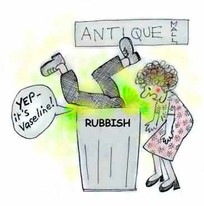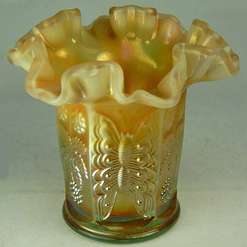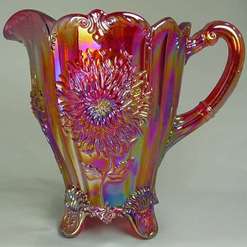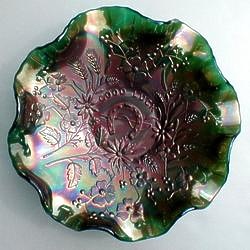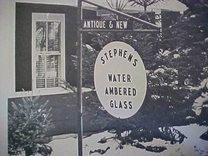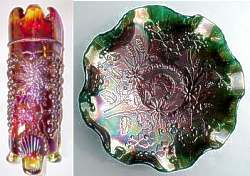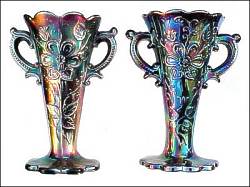Reissues, Reproductions and Fakes
Copyright G & S Thistlewood
As with most sought-after collectables, Classic (old) Carnival Glass has been reissued, reproduced, and faked.
What’s the difference?
In a nutshell, reissues and reproductions are contemporary pressings using original (or possibly re-made) moulds. They were not usually made to deceive. We stress the word “usually", as there are exceptions to this - even though they were made by a bona fide glass factory, and even shown in catalogues, once they get into the secondary market they have the potential to mislead the unwary collector. Fakes however, were specifically intended to deceive.
|
Reissues - used to describe new/contemporary pieces made by the original maker. They could be from the old mould (which may have been re-engineered or re-cut if they were worn or not working properly), or an entirely new mould based on the original pattern. For example, Fenton in the USA made a wide range of items in their old, original patterns, which mostly are marked with their trademark logo - read "Fenton Old and New".
Reproductions - new/contemporary items that are made from old or re-made/re-engineered moulds by a different factory to the original maker. For example the pieces made by Summit using old Westmoreland moulds. Re-made moulds may be in different shapes to the original old ones, or have some pattern differences. Sometimes they will carry the new maker's mark (or signature) but not always. In some cases, contemporary Carnival is being made without removing the old, original maker's mark and there are false N marks on some reproduction Grape and Cable butters and Grape Delight nut bowls. Fakes - items that have been made intentionally to deceive and to be passed off as the genuine article. Examples would be the fake Good Luck, Peacocks and Grape and Cable bowls that are/were made in the Far East - as the whole purpose of a fake is to convince a would-be purchaser that it’s the old, original thing. Fake N marks can be found on many of these pieces. They are different to the original marks: so far (at least), the fake N marks have not been underlined or put inside a circle. They are big, thick capital N marks. |
Let us also dispel an oft-repeated myth, that contemporary Carnival “is shinier, while older Carnival has a satin, almost velvet iridescent finish” This is very misleading - it suggests an easy-fix solution that belies the complexity of the truth. Millersburg’s Radium Carnival, for example, was (intentionally) very shiny indeed, as indeed were many Imperial examples.
Find out more about reissues, reproductions and fakes
The recognition of contemporary reissues, reproductions and fakes is a very wide-ranging topic, of great importance to collectors, and the intention of our Myth Buster! feature is to provide an overview of the subject and provide links to other articles and features for anyone who want to find out more.
We have an ever-growing amount of information on each of these major issues.
Click on these images for an in-depth information and research about reissues, reproductions and fakes. For all collectors, information is power!
|
Reproduction: Mosser made this Dahlia pitcher from the old Dugan-Diamond mould
|
Fakes: don't be deceived by fakes!
Lots of useful information to avoid them. |
Three principles to help identify if a piece of Carnival Glass is a reissue, reproduction, or a fake, are:
1. Assume nothing
2. Check everything
3. Follow the evidence
The first two principles, Assume Nothing and Check Everything, are crucial. Look at every aspect and every clue and consider the wider context as it can bring things into the picture that you may not have considered.
The third principle, Follow the Evidence, underlines absolutely everything and is the crucial rule that is used in all good detective work. Search for clues and all forms of evidence so as to assist research, solve mysteries and inform collectors generally. Don’t get distracted—follow the evidence!
Let us first dispel an oft-repeated myth, that contemporary Carnival “is shinier, while older Carnival has a satin, almost velvet iridescent finish” This is very misleading - it suggests an easy-fix solution that belies the complexity of the truth. Millersburg’s Radium Carnival, for example, was (intentionally) very shiny indeed, as indeed were many Imperial examples.
|
Water Ambered glass is not Carnival Glass
|
We need to add a word about "water ambering", a technique whereby water from some types of mineral springs imparts a pale yellow-brown colour and an iridescent lustre to clear (crystal) glass. Water ambering has been something of a cottage industry in certain parts of the USA, often using EAPG (Early American Pattern Glass). Water ambered glass may have a light iridescent effect, and may sometimes be presented as a "one of a kind" rarity, but it is not Carnival Glass. To find out more, read: "Marlin water ambered glass". |
Read more about how to recognise reissues, reproductions and fakes - click on the links below:
